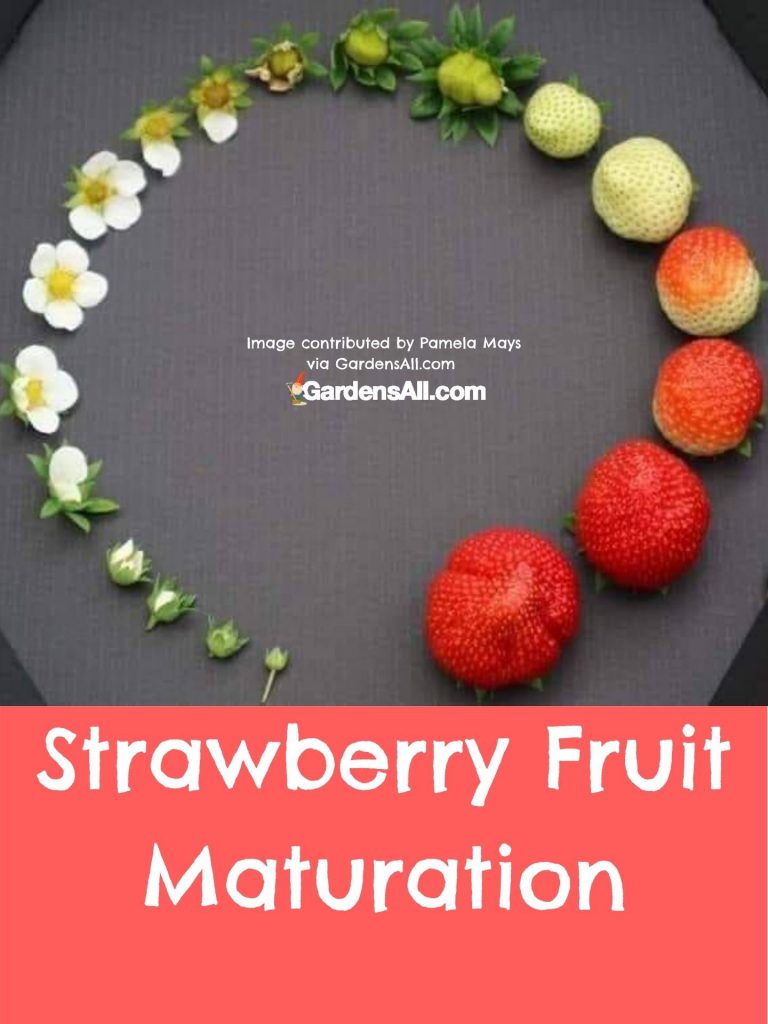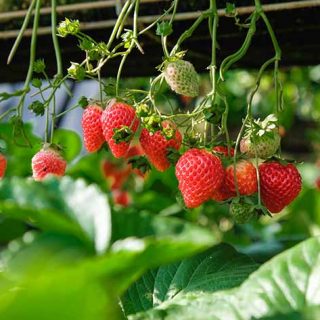Plus Quick Tips for Growing and Caring for Strawberries
Strawberries are a favorite summer fruit that’s easy to grow. If you’re just getting started, you may be wondering how to grow healthy strawberries and also how long it takes for strawberries to grow so you can plan your garden space accordingly.
If you’re a market gardener selling—or planning to sell—your extra produce at your local farmers market, you need to know length of time to harvest on all that you’re growing. A little planning in crop rotation and companion planting, and also yields per square foot can make all the difference in your profitability as a seller of farm-to-table produce.
Patio Gardening
Strawberries are also a great patio plant that grows well in containers. In fact, vertical planters are great for growing strawberries, and better than in the ground growing for several reasons.
We’ve grown strawberries in the Nancy Jane stacking planters and also in terra cotta urn style pots and they’re doing great and thriving. Some have even “hopped out” of the stacked planter and are now growing on the ground around it!
Advantages to Vertical Planters for Strawberries
Nothing quite says that summer has arrived like the sight of fresh strawberries showing up in farmers markets and grocers across the country.
You don’t even need a big garden or large outdoor space to grow strawberries. Many varieties are happy to grow in containers or even in hanging baskets.
Propagating Strawberries
Propagating strawberries from your established plants is really easy. Strawberries send out new runners each summer, all of which can be turned into an exact clone of the parent plant. Just snip the runners you wish to plant with a sharp pair of secateurs, scissors or pruners and pot them into a gritty compost mix.
How Long do Strawberry Plants Last?
If your strawberries start producing smaller yields and fruit, it’s probably time to plant new ones. For best and healthiest yields, it is recommended that you replace each strawberry plant every three years. After that, you’ll notice smaller strawberry yields the older the plant.
So whether it’s planning for your garden space, or a countdown from planting to plucking, just how long does it take for strawberries to grow?
How Long Does it Take Strawberries to Grow?
The length of time it will take for your strawberry plants to start producing their delicious fruits will depend on a number of factors. From the variety you choose to the growing conditions you’re supplying for your plants.
To help you in your garden planning and growing, we’ve put together some useful tips, from length of time for strawberries to grow, to fertilizer and optimum growing conditions. With a few tweaks, you can enjoy growing this delectable favorite perennial garden and patio fruit for years to come.
Timing
Phase 1 – Leaves and Flowers
First, let’s concentrate on the amount of time it will take for your strawberry plants to start producing fruit. As the weather begins to warm up in spring, your plants will put out leaves in order to soak up the sunlight and photosynthesize it into food. This is the first stage of strawberry plants beginning to grow large enough to start producing flowers.
Phase 2 – Flowers to Fruit
On any plant that produces edible crops, wherever there are flowers they’re always followed by fruits or vegetables. The second growing phase of a strawberry plant is the tiny white flowers that appear once the leaves have absorbed enough sunlight to grow to their maximum size.
Phase 3 – Pollination to New Fruit
The strawberry flowers are pollinated by the birds, bees and other flying insects, and begin to grow into strawberries. You’ll notice at first that they are very small and a pale, lime-green color.
Phase 4 – Green to Red – Strawberries!
Your strawberries will soon begin to grow at a fairly rapid speed. Before you know it you’ll have bright red strawberries ready for the picking.
The entire growing process, from the emergence of leaves through to harvest time takes around three months. Strawberries are a late spring, early summer crop, depending on your growing zone and the variety of strawberries you’ve chosen.
3 Months Growth Cycle
How long does it take for strawberries to grow from seedling to fruit? The average strawberry ripening time is three months. In our 7a US growing zone, March to June, is the average strawberry season. However, there are variances between varieties.

Strawberry Varieties
There are numerous varieties of strawberries to choose from, each with their own grow rate.
Varieties such as ‘Honeoye’ and ‘Allstar’ are among the most popular varieties for early cropping, usually around June, and high yields of large fruit. However, bear in mind that although these varieties will produce a crop early on in the season, it also means that they’ll be finished earlier.
Extend Your Strawberry Growing Season
There are two things you can do to extend your strawberry growing season.
- Plant early fruiting strawberry plants, such as ‘Honeoye’ and ‘Allstar’
- Choose a longer producing strawberry plant such as Ozark Beauty.
We’re growing blueberries and have planted several varieties with different primary harvest times to extend the growing season. Next, we’ll do that with strawberries.
Containers & Raised Beds
Whether you’ve got a huge outdoor space or just a small balcony for growing your strawberries on, it’s always best to plant them into either containers or small, individual raised beds. If planted out into the open ground, strawberries have a tendency to overtake with their runners, which can take precious nutrients away from anything else you might be growing in that area.
Planting strawberries into containers constricts runners, which channels growth into leaves and flowers. This in turn, sends signals to the plant to start producing more fruit and rewards you with a higher yield throughout the summer.
Planting Season
Although strawberry plants are perennial, they do need to be planted in the spring in order to start producing fruit effectively. Planting out into sodden or frozen ground will cause the plant to rot and could kill it off altogether.
By waiting for the soil to warm up and for the days to start getting longer and warmer, and then planting out your strawberries, your plants will be happy and you’ll be guaranteed an abundance of fruit.
Soil Preparation & Fertility
Whether you’re growing your strawberry plants in beds, planters or pots, the most important thing you need to make sure of is that the soil you’re putting them in has been well prepared and with all the nutrients needed to grow big, juicy fruits.
Weeds
Making sure your soil is completely free of weeds is the first step in establishing your strawberry plants for high yields. The less competition there is for nutrients from the soil the better chance your strawberries have of growing big, juicy strawberries.
If you’re unsure if something is a weed or not, the best way to think about it is that a weed is something you’ve not purposefully planted there. Therefore, if you see a little green seedling popping up that doesn’t have anything to do with your strawberry plants, pull it out of the soil and make sure you get all of its roots out too.
Maybe Medicine or Food?
Before you pull those weeds, identify them. There are many medicinal plants and edible weeds, so you may want become acquainted with what’s growing in your yard and garden that might actually be a beneficial plant. For instance, in our yard chickweed springs up everywhere, and is a great edible plant.
Soil Health
Another thing to consider before pulling those weeds, is the message they’re giving you. The weeds that grow in your yard and garden give you clues as to your soil health.
Organic Compost – Vitamins for Plants
Incorporating organic matter into your soil will also help your plants grow strong and health. Organic compost fertilizes plant roots with extra nutrients and minerals they need in order to feed the leaves and ward off diseases and pests. Try mixing some organic compost or well rotted manure into your soil before planting.
The best gardens start with the best soil and compost.
Strawberry Pests
Strawberries are also an irresistible snack for slugs and snails. Straw mulch helps prevent pests getting to your precious fruits before you do. So mulch your beds and containers with a thick layer of straw.
Mulch
Not only do slugs and snails find it difficult to crawl across straw mulch, it also serves as a protective layer between your strawberries and the ground, which can help prevent them from getting overly wet and rotting.
Feed When Flowering
Finally, it’s important to give your strawberry plants a good feed with a liquid fertilizer once the flowers have started to appear. This is a crucial step that many gardeners don’t realize they need to do, but feeding your plants helps give them what they need to produce large, tasty fruits.
Plant Food for Strawberries
Plant food such as liquid seaweed, or even a basic tomato plant food, should be applied every 7-14 days.
Full Sun
Strawberries prefer ample sunlight for the highest and best yields of delicious strawberries all summer long.
Follow these simple basic steps and for a healthy strawberry harvest. This healthy foundation will also help ensure that your strawberry plants stay healthy and safe as they over winter, and come back even stronger next year.
Strawberry Recipes
For an awesome strawberry pretzel dessert recipe check out our family’s recipe website.
Whether you’ve got a huge outdoor space or just a small balcony for growing your strawberries on, it’s always best to plant them into either containers or small, individual raised beds. If planted out into the open ground, strawberries have a tendency to overtake with their runners, which can take precious nutrients away from anything else you might be growing in that area.
Planting strawberries into containers constricts runners, which channels growth into leaves and flowers. This in turn, sends signals to the plant to start producing more fruit and rewards you with a higher yield throughout the summer.
We are an online gardening publication sharing all things garden related! Including urban farming, family gardening, homesteading, gardening for profits, and more. We’re all about growth!


